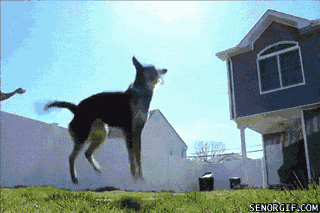


Schipperke are so cool so why don't you have a look at some facts about them!
#1. "The Schipperke is small and described as fox-like."
#2. "The body is square in profile."
#3. "The small nose is black."
#4. "The teeth meet in a scissors or level bite."
#5. "The small, oval eyes face forward on the head."
#6. "The erect ears are high-set and triangular in shape."
#7. "The chest is wide, reaching to the elbows."
#8. "The top line is level or sloping slightly towards the back of the dog."
#9. "They are sometimes born tailless, but if they are born with a tail it is customarily docked to the base to the point where there is no tail visible."
#10. "The thick double coat is shorter on the face, ears, front of the forelegs and the hocks. The coat is medium in length on the body and even longer around the neck, shoulders and rump. Coat color comes most commonly in a solid black,which is the only color accepted by the AKC, but also comes in range of tans and fawns which are acceptable by some other clubs."
#11. "The Schipperke are quick, energetic little dogs."
#12. "High-spirited, alert, and self-confident."
#13. "Very devoted and loyal, especially with children."
#14. "It really bonds to its master."
#15. "Pet cats will be happily accepted and they are usually good with other dogs."
#16. "They are very smart, curious and mischievous."
#17. "These dogs do exceptionally well on boats."
#18. "Among the Schipperke's best qualities are the ability to defend its home against intruders - backing down from nobody, and being an excellent friend to children."
#19. "Some can be difficult to housebreak."
#20. "Socialize well to prevent them from becoming wary and aloof with strangers."
#21. "Easy to train as it is intelligent and eager to learn."
#22. "Schipperke like to howl. After the initial bark to alert you, they need to be told enough is enough and to quiet down."
#23. "Schipperke who are given rules to follow, limits to what they are and are not allowed to do, along with a consistent, firm pack leader, and a daily pack walk, will not develop unwanted behaviors."
#24. "Height: 10-13 inches (21-33cm.)"
#25. "Weight: 12-18 pounds (5.5-8 kg.)"
#26. "Hypothyroid, epilepsy, hip dysplasia and hip sockets which tend to slip. Legg Calves Perthes, Progressive Retinal Atrophy (PRA), Cataracts, and a newly discovered disease called MPS 111B (Mucopolysaccharidosis). There is a genetic test available for the MPS 111B through the Univ. of Pennsylvania. Be careful not to overfeed this breed."
#27. "The Schipperke are good dogs for apartment life. They are very active indoors. These dogs are incredibly quick and it is a good idea to have a fenced yard."
#28. "Schipperkes are an active and tireless breed. To be happy and mentally stable, they need to be taken on a daily, long walk or jog. They also enjoy play and getting a chance to run. This breed is very active indoors and will get a lot of its exercise running around your house. It will greatly enjoy running free off its lead in a safely fenced in yard or a park."
#29. "Life Expectancy: About 15 or more years."
#30. "The Schipperke is very clean and pretty much takes care of its own grooming, but to keep the medium-length double coat in top condition, comb and brush regularly with a firm bristle brush. Dry shampoo when necessary. They shed very little until the coat "blows" which can be as often as 3 times a year on bitches. Less so on males and spayed bitches, especially as they age. This coat change is a sudden drop of ALL undercoat within about a 10 day period. One owner states "I've pulled out up to two shopping bags full of soft down hair out of one 12 pound Schip! I find it easier and quicker to give them a hot bath then force air the coat two or three times during this week (always outside!) to get rid of all the loose, itchy hair before the dog leaves it all over the house. A groomer could do this for the person without a force dryer. They are literally naked and butt ugly for about 2-3 months, depending on the time of year and how much time they spend outside, for the hair to come back to a new lustrous coat."
#31. "The Schipperke was bred in Flanders by a canal boat captain named Renssens. They were descended from a 40 pound (18 kg.) black sheepdog, known as the Leauvenaar, which is the same sheep-herding stock that the black Belgian Sheepdog descended from. The Schipperke was bred smaller and smaller and eventually became a different breed entirely. The dogs became a favorite choice to guard canal barges in Belgium. The breed was used for herding livestock, hunting game, or simply guarding his domain. In Flemish the word "schip" means boat, hence where they got their name "Schipperke". They earned the nickname "Little Captain" and "Little Skipper", because the dogs were the "ratters", a very important function on a canal barge, and also usually the captain's dog. The breed became very popular in Belgian households by the late 1800's. It first appeared at a dog show in 1880. From that point on it was exported throughout the world. The Schipperke do very well on boats and people often get this breed to come along with them on boating and fishing trips. It makes a great guard dog when the boat anchors for the night, alerting of anything out of the ordinary and the dog thoroughly enjoys its trip. The Schipperke was recognized by the AKC in 1904."
Pic of Schipperke face from: http://z.about.com/d/dogs/1/0/f/j/1/ali_schipperke_small.jpg
Pic of Schipperke adult from: http://www.dogbreedinfo.com/schipperke.htm
Pic of Schipperke puppy from: http://rattytime.wordpress.com/author/rattytime/page/38/




No comments:
Post a Comment